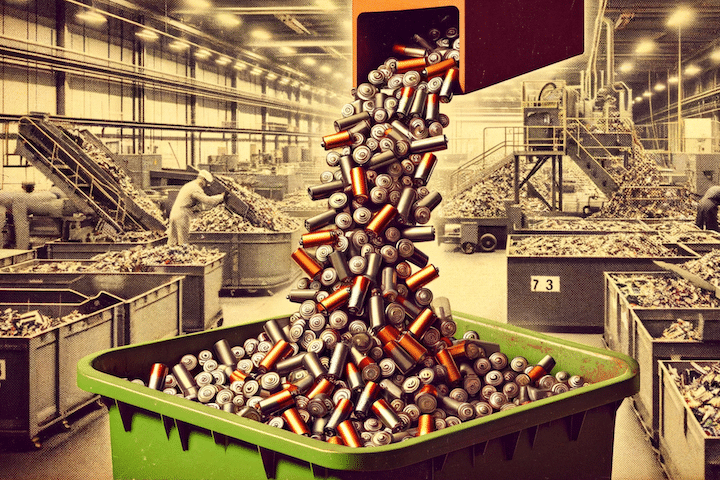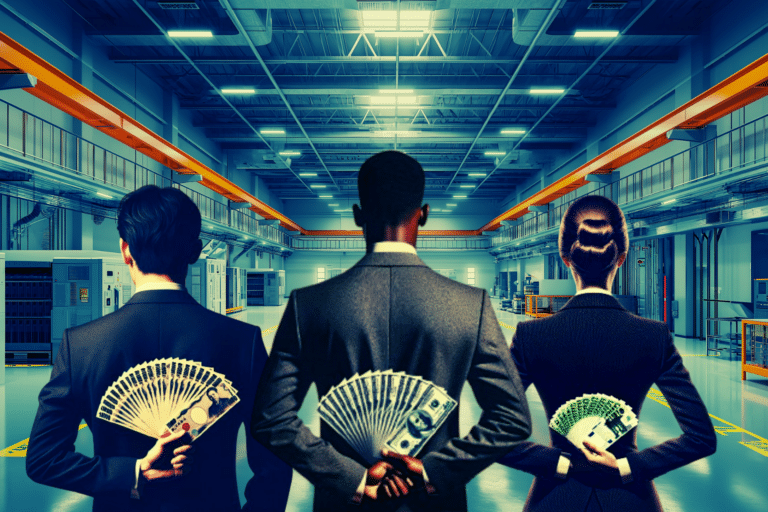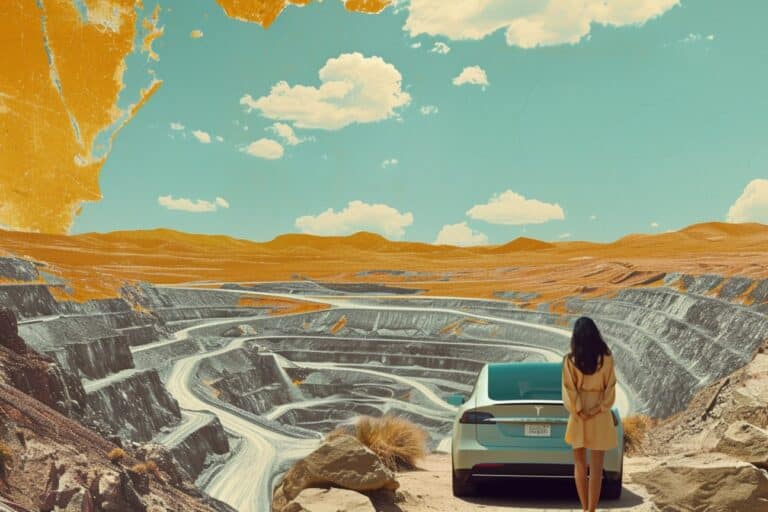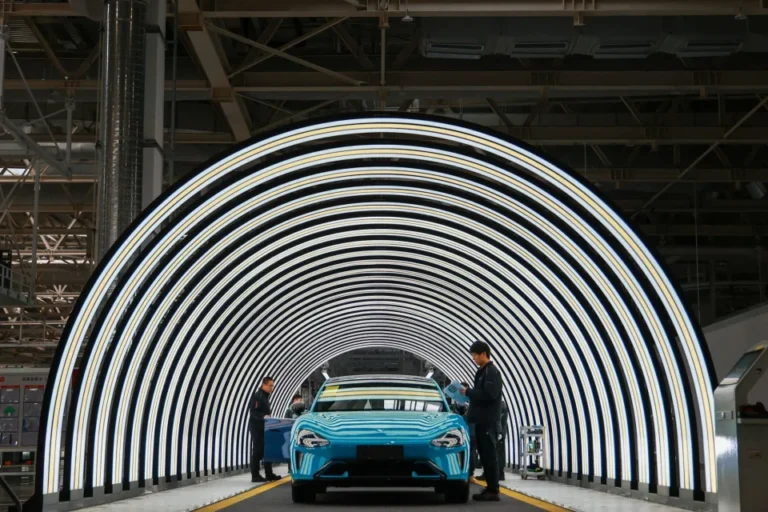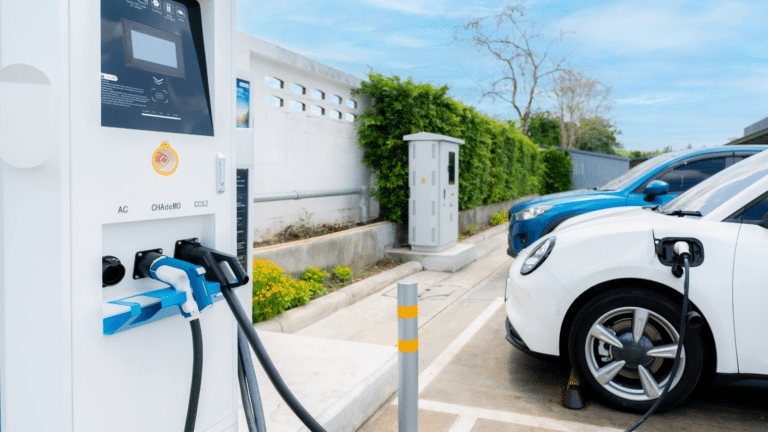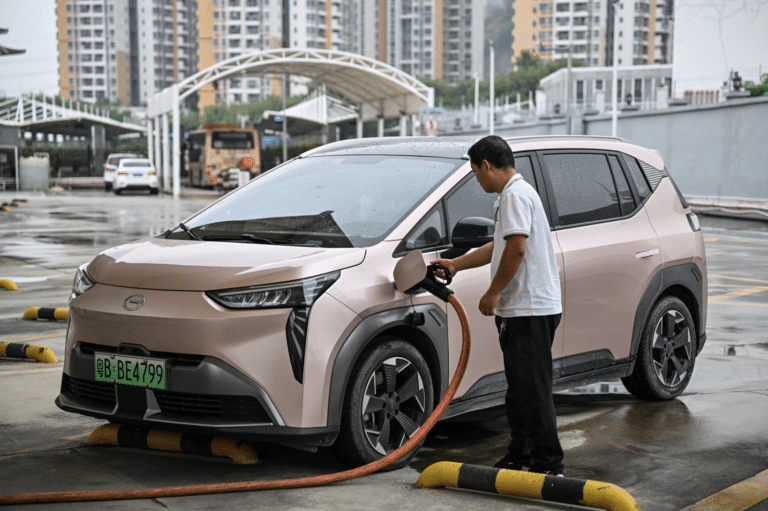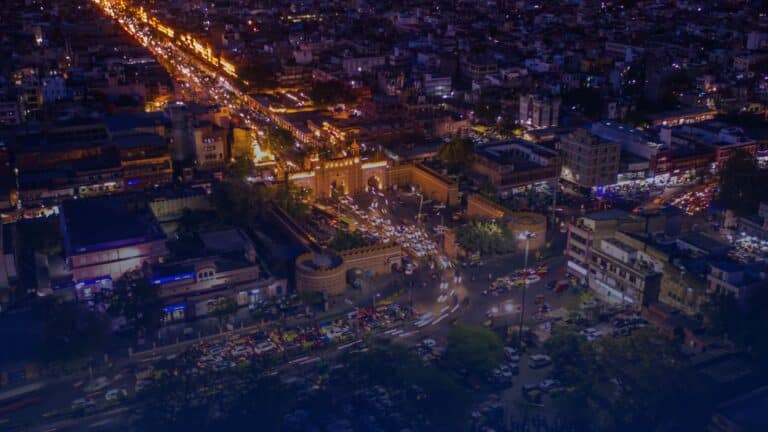Melissa Lott: [00:00:01] Right. Got my mask on. Had it inside for quick stop signs and snacks. Yeah. You haven’t been to a Bucky’s, A. You should go to one. B. They have everything we’re looking at t shirts, Halloween decorations. Need some sunglasses, Need a beavertail. I mean, it’s just everything. Oh, God. The Christmas stuff is already out of it. I love it. I am sitting next to a five foot tall beaver at the moment. [00:00:31][29.7]
Kirsten Smith: [00:00:33] Melissa, do you want me to explain why you were standing next to a five foot tall beaver? [00:00:37][4.2]
Melissa Lott: [00:00:38] I really think you should. I mean, this was your idea. [00:00:40][2.1]
Kirsten Smith: [00:00:40] Okay. I’m Kirsten Smith, and I’m a researcher who works with Melissa at the Center on Global Energy Policy at Columbia and the producers of the show. And I schemed up a plan to hijack Melissa’s road trip. [00:00:52][11.8]
Melissa Lott: [00:00:53] Yes. See, I had this very normal plan. I was going to drive from Austin, Texas, where I live over to Houston for an energy conference. Simple. [00:00:59][6.4]
Kirsten Smith: [00:01:00] Yes. And Houston is like the energy capital of the world and energy conference in the energy capital. It makes total sense to send you on an energy mission. [00:01:07][7.0]
Melissa Lott: [00:01:07] And this is how I ended up recording myself, talking to myself, or at least talking into my phone at a gas station. [00:01:13][5.8]
Kirsten Smith: [00:01:14] I mean, it’s also the gas station of Texas Buckeyes with its mascot, Bucky the Giant Beaver. [00:01:19][4.8]
Melissa Lott: [00:01:20] So I decided to drive to the first Bucky’s. Anyone who’s been to Texas knows Bucky is, and I decided to drive to the first one on my trip to Houston. It’s got endless pumps, huge tanks of fuel underneath the ground. I mean, this is like Disneyland for filling up your vehicle. [00:01:37][17.3]
Kirsten Smith: [00:01:38] Okay, But this. That exactly is why I wanted you to go on this energy mission, Melissa. You have this super power, which is basically that you have X-ray vision for energy. You see energy and things that other people just don’t. [00:01:51][13.4]
Melissa Lott: [00:01:53] This is very exciting. All right. Okay. So to me, this is very exciting. I have just spotted my first power plant of the trip. All the fuel that’s in the tanks. I need my feet right now that I need to put in my car to get to Houston may have come from Houston. It’s probably better from an energy and sustainability footprint for me to buy the bigger bag because the bag material per unit thing I’m eating is probably less. Let’s see. You see one, two, three, four. At least smokestacks. I think about the cow poop in particular and how you can put it into anaerobic digester and actually make fuel. Looks like they got pre and a hot water heater. I wish I could meet those people. That’s pretty cool. Passion inside of that are just massive rollers made of so much metal. You know, so embarrassing. This is a superpower or a nerdy obsession. [00:02:47][53.5]
Kirsten Smith: [00:02:47] Maybe it’s a little bit of both. I mean, why can’t it be both? [00:02:50][2.3]
Melissa Lott: [00:02:51] Okay, we’ll go with that. Both. It sounds like cooler than what I’m thinking right now. [00:02:54][3.4]
Kirsten Smith: [00:02:56] The point of your energy mission, having you drive around and show us where you see energy all around us is really to illustrate the endless ways our society’s going to have to change as we make this big switch to a zero carbon world. [00:03:09][12.7]
Melissa Lott: [00:03:10] Okay, well, let’s go on a road trip. [00:03:11][1.7]
Kirsten Smith: [00:03:12] Let’s go on a road trip. [00:03:13][0.8]
Melissa Lott: [00:03:14] Well, this is the big switch show about how to rebuild the energy systems that are all around us. To slow climate change, we need to transform our buildings, homes, cars and the economy as quickly as possible. But how do we do it right? I’m Dr. Melissa Lott, and I’m the director of research at Columbia University’s Center on Global Energy Policy. And I study the technologies and systems that keep our electric grid running. In the first five episodes of this show, we talked about cleaning up our electricity system, the power grid, and now we have a whole nother year of episodes coming up. And we’re going to explain how to make the big switch in every other sector of the economy, like cars, heavy trucks, planes, industry and buildings. It’s a lot to cover and we need a road map. So in this episode, we’re going to do just that. And that’s why we’re headed out on a road trip. So the thing you forget during COVID is how to pack. No idea how to pack a suitcase. Been in for two and a half days. Barbecue energy talks. That is the question. [00:04:29][75.3]
Kirsten Smith: [00:04:31] So let’s start at the beginning. We’re putting on our Melissa X-ray vision goggles. So show us what you see. [00:04:37][6.5]
Melissa Lott: [00:04:38] So we look around our houses and we’re when I was looking around my house when I was packing, I mean, you start seeing energy in some pretty obvious places. So your lights, your air conditioning, your laundry hands that are run a load of laundry. Tonight, I can almost see the electrons coming out of the wall when I look at those things. But then I went to get what is my favorite suit that I’ve had for a while, and I was pulling it out of my closet and I happened to see the tag and it says a little bit of like nylon and spandex and this. What’s interesting there is that nylon is actually not something grown in a field. It’s actually made from crude oil and chemically processed in this crazy way that makes these really stretchy fibers. And those stretchy fibers can be woven into fabrics. And so you have a bunch of oil in your clothes. [00:05:31][53.6]
Kirsten Smith: [00:05:32] That’s really weird to think about that There’s actually oil in what we’re wearing right now. [00:05:36][3.6]
Melissa Lott: [00:05:37] I mean, it’s really crazy to think about all the things that are in our clothes, period, or just that are around us when we’re sitting here right now. There’s so much going on. And behind every single little thing that seems so simple, there’s this complex supply chain. And this really matters when we’re talking about decarbonizing because we have to think about every single step. So you think about the chemical process for creating nylon. You got to take oil out of the ground, move the oil to where it’s processed. It becomes this input for the thing that becomes the fabric. There’s like 57,000 steps. It’s complicated. [00:06:06][29.6]
Kirsten Smith: [00:06:07] Okay. So you pack your bags and you get on the road. [00:06:09][2.1]
Melissa Lott: [00:06:10] And so I get on the road, but I didn’t get moving very fast right away because I was in rush hour traffic in Texas. We are now sub five miles per hour. And I happened to be sitting behind a heavy commercial truck that is hauling one of the four trucks actually that looks really similar to the work truck I used to drive when I worked for General Mills making cereal when I was first coming out of college. [00:06:37][27.7]
Kirsten Smith: [00:06:38] Wait, you drove a fork truck like a forklift? [00:06:40][2.0]
Melissa Lott: [00:06:41] Yeah. So when I worked in a factory, I was a certified walk truck driver. And that is all very true. And I used to use that fast truck to carry around huge pallets in the warehouse of, oh, clusters and marshmallows and cardboard that became the box for your cereal. And yeah, when I was looking at the truck that was on the back of that commercial track, it had these big silver containers that were filled with propane. We often think just about the propane, like what’s actually pushing us forward. But the reality is that each of the components in this in this work truck came from somewhere and took a lot of energy. So we’ve got all the metal that had to be put together and hardened and made strong enough to carry the hundreds of pounds on each one of these pallets. So when I look at a fast track, I can’t resist breaking it down into its components. This is the complex supply chain we were talking about a second ago. It’s the metals, it’s the plastics, and then it’s all the processes that were used to create those metals and plastics. So there’s tons of heat in those industrial facilities. There’s all the raw materials that had to be pulled out of somewhere and before it could actually get on the road as work truck. [00:07:45][63.9]
Kirsten Smith: [00:07:45] Okay, So you’re driving down the road and thinking about all these different components of a Ford truck, but when did you actually get to Bucky’s? [00:07:52][6.4]
Melissa Lott: [00:07:53] Okay. So I almost didn’t I actually got pretty close to empty on my car. And then I pulled into the Bucky’s parking lot and more than half the pumps were out of service. So I kept driving maybe 12 rows of pumps before I finally found one. And then that pump almost didn’t work. Oh, please, please, please pump work with me. Does not want to accept my credit card. It hasn’t said it’s not going to take it. It just still says processing. It’s like watching the beach ball on your desktop. Okay, It’s restarting. Put in my credit card. X5 data centers are being accessed right now. I feel like kilowatt hours being used as a process to make sure I actually have a right to use my card. So data centers. I’ve been thinking so much about these lately, like data centers are so important and the things we’re doing every day in our life and every single time we use one, it’s using kilowatt hours of electricity. So where do we build them? How do we power them? I mean, every single time I’m watching a YouTube video or getting on Netflix, I am using a data center and I’m using kilowatt hours. It’s another hidden need for energy that is just becoming more and more important as we go into the future. [00:09:07][73.9]
Kirsten Smith: [00:09:07] Yeah, like every time we access a document on the cloud or you’re looking at your phone and you’re you’re calling your friends and your family on FaceTime hopping on Zoom for a call. [00:09:16][8.3]
Melissa Lott: [00:09:16] So exactly. And this is what I’ve been doing for the past 18 months. Whenever I wanted to go to a conference, I was virtual. But now I’m actually going to an in-person conference which requires fuel to physically move me down the road like the fuel I was putting into my car buckets. So, okay, here we go. Yes. Yes. Filling up the tank. Imagining this back years and like 20 years, we’re like, so different. There’s this huge section of parking lot. I mean, this is a massive lot that they bought and built this thing on. And I’m just imagining all the edges being just fast charger, fast charger, fast charger, fast charger for EVs. [00:10:00][43.7]
Kirsten Smith: [00:10:01] And what else are we really going to need to set up that future? Like, what are we going to need to have all those fast chargers. [00:10:06][5.2]
Melissa Lott: [00:10:07] Positing when it comes to Bucky’s and going from moving diesel into my car to putting electricity on my car while at a minimum we’re going to need a lot of new wires and we might need some batteries and some other things. But I don’t know. As I kept going along this road trip, as I kept going down the road, I kept seeing how if we want to get to net zero, we’re going to need so many changes at this point. I mean, I’ve only made it from my home to the first gas station. I haven’t even made it to Houston. And as I leave Bucky’s and I keep going down the road, all I can see when I look out the window is energy, all the energy that’s embedded in our world. I see power plants and pipelines and transmission lines, airplanes that are spraying fertilizer, which is made from fossil fuels. At one point I saw 14 lanes of the Texas freeway filled with cars, 14 lanes. And the question that I keep coming back to is this The economy is huge and there’s energy embedded in every single piece of it. So as we go to net zero, how do we move to those zero carbon alternatives and every single one of those steps? [00:11:08][61.0]
Amber Mahone: [00:11:09] There’s a lot to do. But the good news is that we have the toolkit available, largely relying on existing technologies. There’s a lot of questions about how do we deploy those technologies at scale. But, you know, this isn’t rocket science. We actually know how to do this. [00:11:25][16.1]
Melissa Lott: [00:11:27] This is Amber Mahone. She’s a partner at Energy and Environmental Economics, which is known in energy circles as E-3. She works on deep decarbonization scenarios, which means thinking up all the ways that we can get to 80 or 100% reductions in greenhouse gas emissions economy wide. [00:11:42][15.3]
Amber Mahone: [00:11:43] It’s funny, I’ve been presenting these deep decarbonization scenarios to a really wide range of audiences for a number of years now, and it’s kind of like a Rorschach test where I get a very different reaction, right, from sort of certain communities and like the environmental movement. It’s a really energizing reaction of like, Oh yeah, this is a roadmap. I’ve got a to do list. These are just the things I need to do. And then the other reaction that I get is, Oh man, this is too hard. Like, there’s no way this isn’t going to happen. We should just give up now. And then, you know, I think the reality is that it’s both. It’s really hard. But we also know what we need to do. So are we going to do it. [00:12:27][44.3]
Melissa Lott: [00:12:28] To figure out how we’re going to do it? We need that roadmap that Amber is talking about. In the first five episodes of the show, we talked about the power sector, also known as the power grid or just electricity. This zero carbon power grid will be the backbone of a net zero future, and it will allow us to electrify huge swaths of the economy with clean electrons. But what is in the rest of the economy? What is the roadmap? Or to do this for the rest of the things we need to decarbonize? That’s where Amber and I started our interview. Can you give us a sense of scale as to what a big switch to zero carbon energy means economy wide? And I’m thinking let’s start away from like the easiest sector to the hardest one. And when I say that, I’m thinking first up, first to bat is probably transportation. So what does transportation include? [00:13:15][46.6]
Amber Mahone: [00:13:16] So these are our light duty vehicles that you think of as a car or medium duty vehicles. That’s, you know, the trucks like the Ford F-150, the most popular vehicle in the country. But it also includes medium duty vehicles, which are things like, you know, the Amazon delivery truck in your neighborhood all the way up to heavy duty vehicles, which can include things like long haul 18 wheeler or big rigs, as well as tractors and bulldozers and construction equipment. So that’s we call that the on road transportation sector. And then there’s the off road transportation sector, which is all of the vehicles that are not on roads. Right. And so that includes things like shipping. So both large scale ships that travel internationally to your powerboats that you might play around on the weekend on the lake. So there’s shipping. There’s there’s rail. And there’s aviation. Aviation is maybe one of the harder pieces of the transportation sector to decarbonize. All right. So starting with the light duty vehicles, electrifying light duty vehicles is is already starting to happen. And so that’s where we’re seeing the most progress in sort of the early movement, getting all the way up to the long haul, heavy duty trucking. That’s where it becomes more challenging. [00:14:43][87.1]
Melissa Lott: [00:14:44] What about what comes next. [00:14:45][1.3]
Amber Mahone: [00:14:46] The building sector? We think of that as sort of residential and commercial. The reality is that the building sector is very heterogeneous, but the main sources of greenhouse gas emissions in buildings are from the combustion of natural gas. So it’s not the buildings themselves that are producing the carbon emissions, but it’s the things that we use inside of those buildings. So the furnace that we use to heat our home is often powered by fossil fuels. The water heater that we use to heat our water likewise is often powered by fossil fuels. Our cookstoves and ovens and closed dryers sometimes are also powered by fossil fuels. And so it’s figuring out how do you either switch those end uses to electric or get low carbon fuels to power those instead? That becomes the the trick for decarbonizing buildings. [00:15:42][56.2]
Melissa Lott: [00:15:43] So now we’re at one of the tricky ones industry. What does industry include? [00:15:47][4.1]
Amber Mahone: [00:15:48] Yeah, so the industrial sector is even more heterogeneous than buildings. [00:15:53][5.1]
Melissa Lott: [00:15:54] A lot going on. [00:15:55][0.6]
Amber Mahone: [00:15:56] Yeah. I mean, this is this is everything from oil and gas extraction and refineries to manufacturing processes and chemicals, cement, steel, glass. There’s a different set of solutions depending on what industrial process we’re talking about. We often think about the a key difference being what is the heat temperature that we need for a given industrial process and that. Will dictate the types of solutions that are available. [00:16:29][33.3]
Melissa Lott: [00:16:30] It’s interesting. The more and more I look at things, I think about how heat drives so much of the technologies we need and how we deploy different things. And you can think about heating in your home. But I know when I had my first job out of undergrad and I worked in a food manufacturing facility, we made cereal. We had a five story tall toaster. And you want to talk about heat? I mean, good night. Those are some good corn flakes at the end of it. But on the way down, I mean, they use so much energy in the form of heat and you had to get the temperature right to cool. And they were some not crispy corn flakes too hot and they were burnt to a crisp. So it was one of those things you really think through. But this brings me to my last question, kind of in a sort of step through the power sector, transportation, buildings, industry. When it comes to food, where does agriculture fit in? How much of that is energy? And when we talk about decarbonizing energy, how much is in there and how much is outside of that definition of what energy and the energy sector is. [00:17:23][53.4]
Amber Mahone: [00:17:24] And so most of the agricultural greenhouse gas emissions are outside of the energy sector. In fact, if you think about the tractors on the field, we usually classify those actually as within the transportation sector. They’re a form of off road transportation. So where the greenhouse gas emissions are coming from in the agricultural sector are from methane and nitrogen oxides. The nitrogen oxides are coming from fertilizer application and the methane is a lot of it is coming from the dairy industry, from the meat industry and the the waste associated with that. [00:18:04][40.3]
Melissa Lott: [00:18:05] Yeah, So a lot of poop and some other things from animals, you know, that that these animals that give us things that we want and that we eat, right. [00:18:12][7.3]
Amber Mahone: [00:18:13] I mean. [00:18:13][0.1]
Melissa Lott: [00:18:13] It’s producing a lot of it. So when we talk about all these different parts of the energy systems, the buildings and the cars and the power plants like all these different parts, what are the strategies that we can use in each of these different pieces of the puzzle? [00:18:28][15.3]
Amber Mahone: [00:18:29] Yeah. So there’s a couple strategies that have emerged as consistent across all of the studies and jurisdictions that we’ve looked at. That’s the good news. And I’ll try an analogy to explain these scenarios. And the analogy is that think of the world as our patient in the doctor’s office and the doctor is telling the world, okay, you know, you’re you’re out of shape, you’re at risk of a heart attack, you really have to improve your health. So what are the strategies to get there? You know, the first one is to cut out the empty calories and stop with the junk food. So the equivalent of that in the energy world is to cutting out energy waste to become more energy efficient, to use that energy more wisely to conserve it. So that’s strategy number one. Strategy number two is to improve our diet. So we were raised on, you know, sugary cereals and, you know, Halloween treats as kids. And, you know, that gave us energy and it helped us grow strong. But at some point, we need to move towards a more healthy, balanced diet with whole foods and fruits and vegetables. And that’s what we’re trying to do now, is transition our energy diet to something that is more balanced with clean, renewable energy sources like wind, solar and hydro. So those are the key strategies there. The next one that I might mention and this might be pushing our analogy a little too far. [00:20:11][102.1]
Melissa Lott: [00:20:12] Let’s do it. I’m in it. [00:20:13][1.2]
Amber Mahone: [00:20:13] Okay. So we need a healthy sleep pattern for this medical patient to be healthy. And sleep is what allows us to, you know, recharge and rebuild our bodies in the natural world. We talk about needing to recharge our natural and working lands so that our ecosystems can be healthy to sequester carbon in the soils and in and in the biomass. The last pillar that I’ll also try to tie back to this health and fitness analogy is good hygiene, right? So we need to clean up some of the residue of these fossil fuels that we’ve been burning and that are in the atmosphere. And the way we do that is by pulling greenhouse gas emissions out of the atmosphere. And that’s the that’s our hygiene and that’s our, you know, washing our our bodies with soap. We need a cleaner atmosphere with things like direct air capture. [00:21:19][66.0]
Melissa Lott: [00:21:20] So this patient sounds like they’re doing pretty bad. They need a shower. They need a. Lifestyle shift overall. So how quickly does this need to happen? [00:21:31][10.5]
Amber Mahone: [00:21:32] So it needs to happen very quickly. We have 30 years at best to enable this transition. It’s, you know, one generation. It’s one career. It’s within our lifetimes. The science tells us that by mid-century we need to achieve net zero carbon emissions. And that’s a pace of change that, you know, at best we maybe saw during World War Two, when we mobilize the entire energy economy around that effort. That’s the scale of effort that we’re looking at for the next 30 years. [00:22:13][41.0]
Melissa Lott: [00:22:14] All right. So let’s take a closer look at each of the sectors. I want to dive into transportation first. So, you know, in season one of the show, we did the power sector. We know that the power sector and zero carbon electricity is the backbone of decarbonization. So what is this? Let’s just assume right now that the power sector is cleaned up. It’s well on its way or maybe even at zero carbon across the board. So let’s go into the next in line transportation. So when we think about transportation, what are kind of those I mean, huge bang for your buck kind of things that we see really pushing transportation towards a zero carbon future. What are the big things that carry through that we see? [00:22:52][38.3]
Amber Mahone: [00:22:53] The biggest one is electrification of the light duty vehicles. Electric cars. We see that as being cost effective. The technology is available and it’s also the largest source of greenhouse gas emissions in the transportation sector. That’s where you go first. The pillars of decarbonization apply to all of the sectors, and so we can think about energy efficiency as well in the transportation sector, and that can be improving the fuel economy standards of cars. But the big one that where all that the carbon is is in getting off of fossil fuels, getting away from internal combustion engine vehicles to alternatives, that mostly means electric vehicles. But in some cases it may mean hydrogen fuel cell vehicles, particularly for heavy duty transportation. Potentially. It may also mean the use of biofuels or synthetic fuels in the sectors of transportation that are really challenging to electrify. [00:23:56][62.7]
Melissa Lott: [00:23:57] So I know that one of our conversations we had, Professor Destinee Knox, she’s from Carnegie Mellon, and she was talking to us about how depending on the choices we make in a zero carbon world, we can either make equity gaps bigger or we can narrow them. And so I’m wondering what the equity implications that we should be thinking about in a net zero transportation world where so much is electrified, so much is more efficient. What are those equity concerns that we just need to make sure that we are putting into the strategies and remembering there’s. [00:24:25][28.3]
Amber Mahone: [00:24:26] So many equity considerations? You know, the sad fact is that a lot of the electric vehicle incentive dollars that we’ve made available so far have gone to middle class and wealthy families. So how do we help lower income or traditionally disadvantaged communities benefit from the lower cost of owning and operating an electric vehicle or the air quality benefits of electrifying the transportation sector? I think, you know, some of it is thinking about transportation a little bit more broadly. It doesn’t need to be about owning your own single family home or single family vehicle all the time. We want to think about electric, public transit, access to shared vehicles and shared electric charging. [00:25:21][54.9]
Melissa Lott: [00:25:22] I mean, this is another key part of the efficiency thing, right. And also equity in this transition. So if we want to reach peak efficiency, you don’t have a bunch of solo people driving around in cars. You have public transportation. You try to get that density up. There’s a lot of different things you do. So I want to step into buildings and just think through how do we apply these pillars that you were talking about across buildings? What does that look like? And what is if you had to pick one or maybe two key strategies to buildings, what are they? [00:25:52][29.9]
Amber Mahone: [00:25:52] The first thing to know about buildings is that today about half of the emissions are coming from the use of electricity and the other half are coming from the use of mostly natural gas, but other fuels. And we know we’re going to be decarbonizing the electricity sector. But what’s our plan for the fossil fuels in buildings? The biggest source of fossil fuel use in buildings is space heating. And so that’s the key strategy to think about. The second biggest one, you know, if you especially if you live in a warmer climate. Like. Like I do. It’s water heating. So those are the big ones and buildings. And there’s a couple strategies for decarbonizing space, heating and water heating. One of those is a technology called heat pumps. Would you like me to explain what a heat pump is and what. [00:26:44][52.2]
Melissa Lott: [00:26:45] Yeah, what is a heat pump? Because we hear about these a lot as being a potential solution to keeping us cool and warm in our homes. But what are they and how do we use them? [00:26:53][7.8]
Amber Mahone: [00:26:53] Right. So a heat pump you can think of as like an air conditioner that can run in two directions. It can both heat and cool. A refrigerator also uses a heat pump to provide cooling. And so this is a technology that runs on electricity. It happens to be very efficient. And there are heat pump water heaters that heat water with with electricity. And there are different types of heat pumps that also provide space heating and space cooling. [00:27:24][30.7]
Melissa Lott: [00:27:25] And I’m wondering, so in all of this, I want to talk about those equity gaps again. So when we think about going to net zero on our buildings, you know, I mean, we often when we go into the global energy system discussions, we think about energy access. People who don’t have electricity in their homes don’t have access to clean fuels for cooking, much less having an air conditioner to keep them, you know, cool and healthy in the summers. But I’m actually also thinking about how do we make sure that our buildings are places people can live and live at a healthy temperature in a way that doesn’t like break the bank and make them not able to pay their bills. So what do you think about with equity in buildings, though? [00:28:02][37.1]
Amber Mahone: [00:28:03] That’s exactly right. The buildings that low income people live in are often not very high quality. They’re often not very well insulated. And so their energy bills end up being higher. So energy efficiency is an equity consideration. This switch to efficiency and electrification also is is easier if you own your own home and you have access to the money to pay for those upfront investments. So renters, sometimes we worry they’ll be left behind in this transition. Or if you don’t have, you know, the available funds to to pay for the more efficient equipment, you’ll be left out as well. [00:28:48][45.2]
Melissa Lott: [00:28:49] So, okay. I want to touch really briefly on industry. So in industry, we’ve got things like iron and steel, cement, petrochemicals, which include, I mean, all types of different things that go under our clothes and the fertilizers, just a lot of different stuff. What are the key strategies that we need to be thinking about with industry? What are the key levers we can pull that give us really big bang for our buck an industry? [00:29:11][22.3]
Amber Mahone: [00:29:12] So it’s the same strategies as the same fundamental strategies. But in industry, it’s just a little bit harder because there’s not a simple drop in solutions. So we still want to do energy efficiency and conservation. We still want to electrify end uses that we can. And there are low temperature process heating applications, an industry that can be electrified. There’s also interesting ways to use electricity to like infrared technologies that can purify food. So there’s ways to electrify portions of the industrial sector. But the reliance on hydrogen is probably going to be a little bit higher as we think about decarbonizing the industrial sector, because it is a fuel or it’s an energy carrier that can be that can be stored and that can achieve high temperatures that that you need for some industrial processes. [00:30:11][58.3]
Melissa Lott: [00:30:12] All right. So what are the other parts of the economy that we need to be thinking about? [00:30:15][3.3]
Amber Mahone: [00:30:16] Well, two big ones are what we call non-energy greenhouse gas emissions. So everything we’ve been talking about so far has mostly been about CO2, but there are also other gases that are very detrimental to the climate and those we sometimes call high global warming potential gases. And those are primarily methane. So, you know, natural gas leaks have it’s a very potent greenhouse gas. And the other one is a high global warming potential gas that we use in our refrigerators, in our air conditioners. And these are fluorinated gases. Sometimes we call them HFCS, and those are even more potent than methane. There’s less of them in total. So that’s the good news. But the fact that they’re so potent means that we need to use less of them and transition to other refrigerant fluids in our air conditioning, in our in our heat pumps, for that matter. [00:31:18][62.7]
Melissa Lott: [00:31:19] How can to go back to something you said? So I’m thinking about negative emissions and negative emissions technologies. I think in your in. OLogy. It was the actually taking a shower and making sure we’ve clean things up. Can we talk through that just a little bit more, which is how do we stabilize the climate with things like I’m thinking about director captures that what you think about or do you think about other things as well? [00:31:40][21.0]
Amber Mahone: [00:31:41] There’s other strategies as well. So direct air captures, you know, maybe the most direct just use some big machines to suck a bunch of air through these chemical filters and pull the CO2 directly out of the air. There’s a lot of innovation in this space as well, though, around other strategies. So, I mean, I guess a big one is using our natural and working lands as carbon sinks and ways that we can enhance our ecosystems and our environment to actually help us pull CO2 out of the atmosphere. You know, that’s what our forests and trees already do. But we’ve also been cutting down our forests in the Amazon and across the world at a really rapid pace. And so regrowing those forests and managing our lands with carbon sequestration in mind is a really powerful strategy. [00:32:36][55.5]
Melissa Lott: [00:32:37] Of all these things that we’re talking about. Amber how much of this is already happening? Like, where are we already making progress and where are we making progress yet? And we might need to shift our focus to yeah. [00:32:49][12.0]
Amber Mahone: [00:32:50] So we’ve actually made the most progress in the electricity sector. There’s been an incredible transition away from coal towards more natural gas, and we’re starting to see a transition away from natural gas to renewables. So that’s been amazing and that progress has been more rapid than anybody expected even a decade ago. We’re starting to see the beginnings of progress on electrifying vehicles with with electric cars. But we’re just in the early days of that. But I think we’re going to see that accelerate, where we’re not seeing as much progress is in buildings and in the industrial sector. Those greenhouse gas emissions are sort of still flat. They haven’t really changed haven’t moved the needle on those yet. Same is true in the agriculture sector. So we’re doing well in electricity. We’re starting to see progress in transportation, but we’re not yet seeing much progress in buildings, industry, in agriculture. [00:33:52][61.8]
Melissa Lott: [00:33:56] Amber Bohannan is a partner at Energy and Environmental Economics, where she directs their clean energy team. And this is the team that looks across all sectors of the energy economy to figure out the feasibility and implications of long term climate solutions. [00:34:09][13.3]
Kirsten Smith: [00:34:14] So, Melissa, back to your road trip. How do you make it to Houston without getting distracted by all the endless hidden energy you saw along the way? [00:34:21][7.1]
Melissa Lott: [00:34:22] So I got into the room. I should have been relaxing. But, you know, of course, the first thing I did was call Jason and Laurie from our center to say, Hey, where are you guys at? Did you plane land? Let’s meet up. And then I found myself thinking about I wonder how much more efficient it was to have two people fly down from New York and one person drive from Austin versus what would our footprint have been if I’d flown up to New York? And they driven over and I started running all these different scenarios in my head. And it’s just complicated. [00:34:49][26.8]
Kirsten Smith: [00:34:50] Melissa is just such a nerd. You can just hear the excitement like she can’t turn it off. This is just how her brain works. [00:34:57][6.4]
Melissa Lott: [00:34:58] It’s a curse. Like it’s a curse. And that’s our show and the end of my road trip. We would be so grateful. If you can give us a rating your review on Apple Podcasts, and if you think the show would be valuable to a colleague, a friend, or in a classroom, please share it. Put it on social media, send them a link, or tell them to pick up their phone right in front of you and hit subscribe because we have a whole year of episodes ahead of us. So we’re going to dive into each of these sectors. We’re going to focus on other parts of the energy system, such as agriculture, cars, busses, shipping, heavy industry and just other parts of the economy. The big switch is produced by Columbia University’s Center on Global Energy Policy in partnership with Postscript Media. This episode was produced by Daniel Alder, a special thanks to Kirsten Smith, my co-host on this episode, and also to Jenna martin Kewley and Liz Smith and Natalie Volk, our executive editor, Stephen Lacy. I’m Dr. Melissa Lott. And this is the big switch. Let’s go on a road trip. [00:35:55][56.8]
Kirsten Smith: [00:35:55] Let’s go on a road trip. [00:35:55][0.0]
[2080.8]




